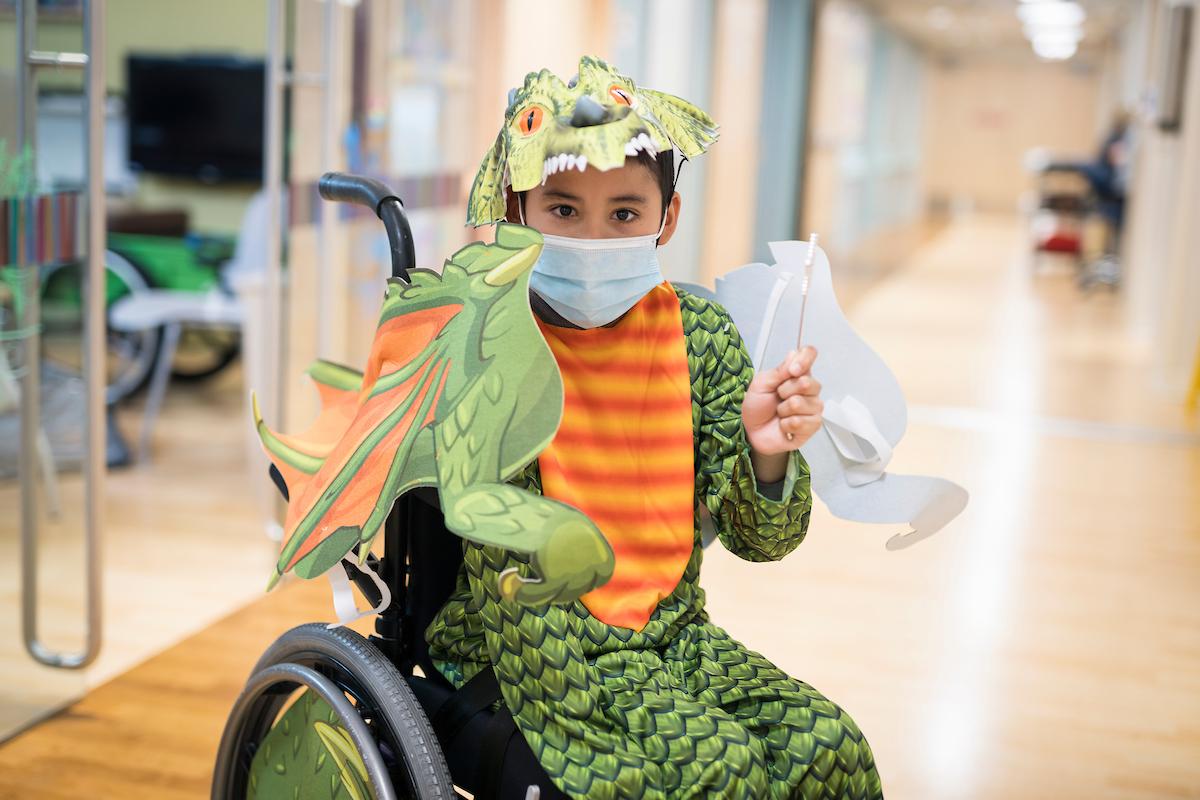
Maya’s two main Gillette therapists, speech language pathologist, Lisa Schwartz, and occupational therapist, Emily McCarthy, often work as a team to help children who have complex medical conditions.
Maya Xiong loves listening to Korean K-POP music, having her nails polished and spending time with her three siblings. Her dad, Wang, describes her a “jolly kid.” Her mother, Kao, concurs and says 6-year-old Maya “is a beam of sunshine in our family.”
Both parents credit the Gillette Children’s Specialty Healthcare team approach to care for helping their family stay upbeat as they deal with some serious health issues for Maya. “Everyone at Gillette is positive,” Kao says. “Everyone really tries to find the best therapy, equipment and medications for Maya.”
Maya’s birth was uneventful and, for a time, she was progressing well as an infant. But when Maya was about a year old the Xiong family noticed she started missing milestones and she was declining. “When Maya started to lose the ability to walk we became really concerned and took her to Gillette,” Wang recalls.
That first appointment started a journey to get a diagnosis for Maya and to create a care plan to help her. “They did lots of bloodwork and genetic testing,” Wang says. “It was hard because we needed patience while the doctors tried to diagnose her and find some answers.”
When Maya was eventually diagnosed with infantile neuroaxonal dystrophy (INAD) her dad remembers the news as “a shock and heartbreak.”
INAD is a rare, genetic neurological disorder. Symptoms usually present between 6 and 18 months of age and there is often a rapid decline of motor and intellectual skills. According to the National Institute of Neurological Disorders and Stroke, there is no cure for INAD and no treatment that can stop the progress of the disease. Doctors and therapists can help with medication for pain relief and exercises to maintain comfort. At Gillette, Maya’s team is focused on improving her quality of life and allowing her to reach her potential.

Gillette occupational therapist, Emily McCarthy, helps Maya learn the physical skills needed to use an eye gaze augmentative and alternative communication (AAC) device.
A Team Approach to Communication
Maya’s two main Gillette therapists, speech language pathologist, Lisa Schwartz, and occupational therapist, Emily McCarthy say Maya is very “happy, smiley and engaged” during her therapy sessions. The two therapists often work as a team and first began seeing Maya to help with the way INAD effects Maya’s muscles needed for eating and swallowing. “Gillette is really known for a team approach and letting two therapists co-treat a patient if it’s needed,” McCarthy says.
Maya’s parents are very involved in her care and used the tools learned in therapy to help Maya at home. Maya’s dad says she has a limited vocabulary of about five words now and says she’s good at communicating her needs with her very expressive eyes. He and Kao wanted Maya to be able to engage more with her three siblings and asked for some communication options.
Schwartz and McCarthy evaluated Maya and determined which augmentative and alternative communication (AAC) device would work best. McCarthy says, “As an occupational therapist I looked at Maya’s physical needs and skills while, Lisa, as a speech therapist, evaluated Maya’s language and communication skills.”
The two therapists are working with Maya to use an eye tracking device that uses an infrared camera calibrated to Maya’s eyes to determine which word she’s looking at on an electronic tablet. “We want her to be able to use that device to communicate different functions,” Schwartz says. “So, for example, commenting, labeling, requesting and protesting. One of the first things we’re teaching Maya is ‘more.’ We know she likes to listen to K-POP music so we’re working with her to use her eye gaze to request ‘more’ if she’d like to hear more music.”
Schwartz and McCarthy frequently use the skills from Gillette’s internationally recognized Orthotics, Prosthetics and Seating (OPS) department to make sure a child is properly set-up to use an AAC device. The OPS experts ensure a child’s wheelchair has the equipment it needs for a communication device and that a child has the proper back and head support. “At Gillette we work with a lot of kids with complex medical needs,” Schwartz says. “We have more knowledge with the eye gaze and facial recognition systems that you just don’t see in smaller clinics.”

Maya Xiong and her mom work with Gillette therapists to use an eye tracking communication device that uses an infrared camera calibrated to Maya’s eyes to determine which word or image she’s looking at on an electronic tablet.
“What we want is a child who can communicate with the world.”
Schwartz and McCarthy say a child’s ability to communicate is key to helping with their overall quality of life. “Helping a child communicate gives them the opportunity to be social with others,” McCarthy says. “A lot of times we get families that come to us and the parents say ‘Well, I know what my child wants and I can tell just by looking at them.’ That is nice, but what we really want is to give the child the opportunity to communicate with anybody within their community, within their school, with their therapist or caregiver. What we want is a child who can communicate with the world.”
Schwartz agrees, “I want to just empower families and empower these kids to communicate what they want and need. It’s just the best job in the world!”
Schwartz can get emotional when she thinks about communication breakthroughs from young patients she’s helped. “A few years ago in one of my first sessions with a patient he was able to use a communication device and was able to say ‘I love you’ to his mom and dad. All of us started crying because it was very purposeful. He said it and then looked directly at his mom and dad.”

Maya’s parents are devoted to her care and work with the team at Gillette to make sure she’s comfortable and able to communicate.
Parents and Partners
Wang and Kao Xiong are hopeful about Maya’s future and are eager to help her work on her communications skills. The family can test the AAC eye gaze equipment at home before making a commitment to a certain device. “It’s so nice that Gillette and the therapists are letting us try different communication devices to see which one works best for Maya and our family,” Wang says.
The Gillette therapy team knows that having a child with a complex medical condition can be a challenge for the entire family. “Maya’s mom and dad have both shown a devotion to help Maya,” Schwartz says. “As a therapist I always appreciate what parents do for their child. They are really partners with the therapy team.”
Kao admits she has some hard days dealing with Maya’s condition but she’s active with an INAD online support community. “This condition is rare,” Kao says. “So there are only about 240 members of the group worldwide. I appreciate the support. We help each other.”
Wang beams when he talks about his wife and daughter. “My wife is amazing,” he says. “I could not ask for a better partner. With Maya we don’t know what’s going to happen even next week. All I know is my daughter always has a smile and she loves her family. That keeps us going.”




